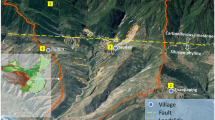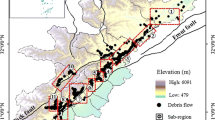Abstract
A characteristic rainfall is introduced to overcome the difficulties encountered in determining a critical rainfall value for triggering debris flow. The characteristic value is defined as the rainfall at which debris-flow occurrence probability shows a rapid increase, and can be used as a warning rainfall threshold for debris flows. Investigation of recorded debris flows and 24-hour rainfall data at Jiangjia basin, Yunnan Province, in southwestern China, demonstrates the existence of such a characteristic rainfall. It was found that the characteristic rainfall corresponds to the daily rainfall of 90% cumulative probability by analyzing the basin’s daily rainfall histogram. The result provides a simple and useful method for estimating a debris-flow warning rainfall threshold from the daily rainfall distribution. It was applied to estimate the debris-flow warning rainfall threshold for the Subaohe basin, a watershed in the 2008 Wenchuan earthquake zone with many physical characteristics similar to those of the Jiangjia basin.
Similar content being viewed by others
References
Bovis, M. J. and Jakob M. 1999. The Role Of Debris Supply Conditions In Predicting Debris Flow Activity. Earth Surf. Process. Landforms 24:1039–1054.
Caine, N. 1980. The rainfall intensity: duration control of shallow landslides and debris flows. Geogr Ann A 62:23–27.
Cannon, S. H. and S. Ellen. 1985. Rainfall conditions for abundant debris avalanches, San Francisco Bay Region, California. California Geology 38: 267–272.
Casadel, M., Dietrich, W. E., and Miller, N. L. 2003. Testing a model for predicting the timing and location of shallow landslide initiation in soil-mantled landscapes. Earth Surf Proc Land 28:925–950.
Chen J. 1985. A preliminary analysis of the relation between debris flow and rainstorm at Jiangjia Gully of Dongchuan in Yunnan. Memoirs of Lanzhou Institute of Glaciology and Cryopedology of Chinese Academy of Sciences (No.4). Science Press, Beijing: 88–96. (In Chinese)
Chen, C. Y., T. C. Chen, et al. 2005. Rainfall duration and debris-flow initiated studies for real-time monitoring. Environmental Geology 47(5): 715–724.
Cui, P., Chen, X., Wang, Y., Hu, K.-H., and Li, Y. 2005. Jiangjia Ravine debris flows in south-western China, in M. Jakob and O. Hungr, eds., Debris-flow Hazards and Related Phenomena: Berlin Heidelberg, Springer-Praxis: 565–594.
Cui, P., Chen, X.Q., Zhu Y.Y. et al. The Wenchuan earthquake (May 12, 2008), Sichuan Province, China, and resulting geohazards, Nat Hazards, DOI 10.1007/s11069-009-9392-1. (preprint)
Gabet and Mudd. 2006. The mobilization of debris flows from shallow landslides. Geomorphology 74:207–218.
Godt, J. W., Baum, R. L., and Chleborad, A. F. 2006. Rainfall characteristics for shallow landsliding in Seattle, Washington, USA. Earth Surf Proc Land 31:97–110.
Iverson, R. M., Reid, M. E., and LaHusen R. G. 1997. Debrisflow mobilization from landslides, Annu. Rev. Earth Planet. Sci. 25:85–138.
Iverson, R. M. 2000. Landslide triggering by rain infiltration. Water Resources Research 36(7): 1897–1910.
Kang ZC., and Zhang SC. 1980. A preliminary analysis of the characteristics of debris flow. In: Proc. int. symp. river sed., Beijing, China, 1:213–226.
Li, J., Yuan, J.-M, et al. 1983. The main features of the mudflow in Jiang-Jia Ravine. Z. Geomorph. N. F. 27(3):325–341.
Lin, C. W., C. L. Shieh, et al. 2004. Impact of Chi-Chi earthquake on the occurrence of landslides and debris flows: example from the Chenyulan River watershed, Nantou, Taiwan. Engineering Geology 71(1–2): 49–61.
Montgomery, D. R., and Dietrich, W. E. 1994. A physically based model for the topographic control on shallow landsliding. Water Resour. Res. 30(4):1153–1171.
Savage, W.Z., Godt, J.W., and Baum, R.L. 2003. A model for spatially and temporally distributed shallow landslide initiation by rainfall infiltration, in Rickenmann, D., and Chen, C., eds., Debris- flow hazards mitigation-mechanics, prediction and assessment: Rotterdam, Millpress: 179–187.
Terlien, M. T. J. 1998. The determination of statistical and deterministic hydrological landslide-triggering thresholds. Environmental Geology 35(2–3): 124–130.
Wieczorek, G. F. 1987. Effect of rainfall intensity and duration on debris flows in central Santa Cruz Mountains, California. Geological Society of America Reviews in Engineering Geology 7: 93–104.
Wilson, R. C. 1997. Broad-scale climatic influences on rainfall thresholds for debris flows: adapting thresholds for northern California to southern California. Geological Society of America Reviews in Engineering Geology 11:71–80.
Wilson, R. C. 2000. Climatic variations in rainfall thresholds for debris-flow activity, Proceedings of First Plinius Conference on Mediterranean Storms, Mareta, Italy, 14–16 October 1999, Claps P, Wieczorek GW (eds). European Geophysical Union: 415–442.
Author information
Authors and Affiliations
Corresponding author
Rights and permissions
About this article
Cite this article
Hu, K., Cui, P., Wang, C. et al. Characteristic rainfall for warning of debris flows. J. Mt. Sci. 7, 207–214 (2010). https://doi.org/10.1007/s11629-010-2022-2
Received:
Accepted:
Published:
Issue Date:
DOI: https://doi.org/10.1007/s11629-010-2022-2




